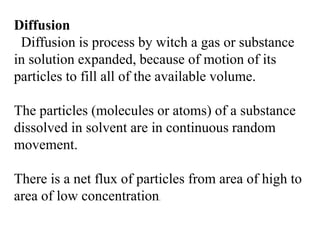
Diffusion and Osmosis Processes in Cells
- 1. Diffusion Diffusion is process by witch a gas or substance in solution expanded, because of motion of its particles to fill all of the available volume. The particles (molecules or atoms) of a substance dissolved in solvent are in continuous random movement. There is a net flux of particles from area of high to area of low concentration.
- 2. The time required to equilibrium by diffusion is proportionate to the square of the diffusion distance. The value is directly proportionate to cross sectional area of diffusion and concentration gradient or chemical gradient (is the difference in concentration of the diffusing substance divided by the thickness of the boundary)
- 3. .(Fick,s low of diffusion ) Thus J= -DA ∆c ∆x J is net rate of diffusion D is the diffusion coefficient A is the area ∆c/∆x concentration gradient The minus sign indicate the direction of diffusion when movement from high to lower concentration ∆c/∆x is negative so x-DA gives positive value. Q
- 4. Osmosis When substance is dissolved in water, the concentration of water molecules in the solution is less than that in pure water The solution occupies a greater volume than dose the water alone. If the solution is placed on one side of membrane that is permeable to water but not to solute, and equal volume of water is placed on the other.
- 5. water molecules diffuse down their concentration gradient into the solution. Osmosis is process of diffusion of solvent molecules into a region in which there is a higher concentration of solute to which the membrane is impermeable. osmotic pressure of solution is pressure necessary to prevent solvent migration.
- 8. Osmotic pressure lowering freezing point depression and boiling point elevation, depends on the number rather than the type of particles in solution. In ideal solution , osmotic pressure is related to temperature and the volume. P=nRT/V n number of particles R gas constant T is absolute temperature V volume
- 9. If T is held constant, the osmotic pressure is proportionate to the number of particles in solution per unit volume of solution. The concentration of osmotically active particles is expressed in osmoles . One osmole (osm) equals the gram- molecules weight of a substance divided by the number of free moving particles in solution. Milliosmole (mosm) is 11000 of 1 osm.
- 10. If a solute is nonionizing compound such as glucose , the osmotic pressure is a function of the number of glucose molecules present. If a solute is ionizes and forms an ideal solution, each ion is an osmotically active particle. – NaCl ……… Na+ and Cl- ions so that each mole in solution would supply 2 osm One mole of Na2so4 dissociate into …………………..
- 11. The body fluids are not ideal solutions and although the dissociation of electrolyte is complete the number of particles is reduced to interactions between the ions 1mmol of NaCl per liter in the body fluid contribute less than 2mosm of osmotically active particles .
- 12. The osmolartiy is the number of osmoles per liter of solution ( plasma) The osmolality the number of osmoles per kilogram of solvent The osmolartiy is affected by the volume of various solutes in the solution and the temperature while the osmolality is not . Osmolality is expressed in milliosmol per liter .
- 13. Osmolal concentration of plasma : Tonicity The freezing point of normal human of plasma averages -0.54 C0 -corresponds to an Osmolal concentration of 290 mosmL. All fluid compartment of the body in or nearly in osmotic equilibrium. . The term tonicity is used to described the osmolality of solution relative to plasma solution That have the same osmolality as plasma are isotonic , those with greater osmolality are hypertonic and with lesser osmolality are hypotonic.
- 14. 0.9% saline solution is isotonic 5% glucose solution is isotonic when initially infused intravenously but is metabolized so the net effect is hypotonic solution. 270mosm in each liter of plasma are contributed by Na+ and its accompanying anions - Cl- and HCO- 3 plasma protein less than 2 mosmL
- 15. Glucose and urea about 5 mosmL but become large in hyperglycemia or uremia. The total plasma osmolality is important in assessing dehydration and overhydaration Hyperosmolality can cause coma- hyperosmolar coma.
- 16. Regulation of cell volume Cell membrane is flexible , swell when exposed to extracellular hypotonicity and shrink when exposed to hypertoncity. Cell swelling activates channels in cell membrane increased efflux of K+,, Cl- and small organic solutes. water follows these osmotically active particles out of the cell and cell volume return to normal .
- 17. Nonionic diffusion For weak acids and bases which pass the cell membranes in undissociated form , whereas they cross membranes with difficulty in the ionic form. If molecules of undissociated substances diffuse from one side to other of membrane and then dissociate. there is net movement of the undissociated substances from one side of membrane to the other. This occurs in gastrointestinal tract and kidney.